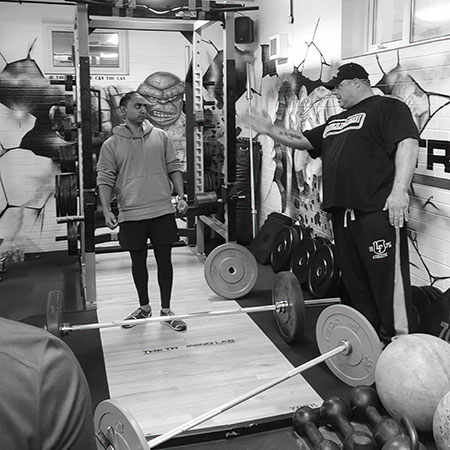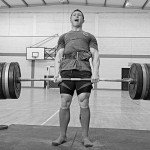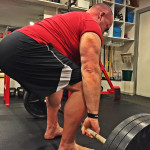A couple weeks back, my friend Elliot and I went to a seminar held by our good friend Mehdi of Stronglifts. After I’d given my talk, the guys and gals at the seminar got practical and did a ton of squatting and deadlifting. While I was impressed with much of what I saw, there was one thing me and Elliot noticed time and time again.
And it was this thing—or rather the lack of it—that was causing most of these lifters to be lifting a lot less than they were capable of.
The 1 Thing You’re Probably Missing, Too
For instance, there was this 48-year-old guy who told me he had a deadlift 1RM of 264lbs. Not bad for a guy who’d only been lifting six months, but not exactly setting the world on fire either. For the record, he probably weighed 210.
Anyway, I helped him out by getting him to do the one thing he wasn’t doing and guess what he pulled? Any offers?
352lbs.
Yep. That’s not a typo. He went from a 264 max to a 352 max—an 88-pound difference.
Guess how long it took?—ten minutes tops. A 33% increase in his 1RM on the deadlift in ten minutes. How is this possible? Simple.
I taught him how to get tight. It’s this tightness that is the key to instant strength gains.
What I saw at the seminar was a bunch of lifters with fairly decent form. Most had neutral spines when squatting and deadlifting. Most had a reasonable width of stance, gripped the bar in a fine way, and so on. But almost without exception, they didn’t understand how to get tight.
The reality is you can have good technique in terms of body positions—but if you don’t know how to get tight, you’ll always be weak as a kitten.
When it comes to strength, tightness is the master principle. Why? Because the tighter you get, the more force you generate. And the more force you generate, the more weight you lift. Pretty simple, really.
To prove my point, let me tell you about one of my training partners, Ronnie. Ronnie is a very strong man. He’s deadlifted over 661 in competition, in the 198 weight class. Ronnie also deadlifts with a very rounded back. He’s never considered technique and he never will. You wouldn’t teach somebody to lift how he does. Yet the truth is, he’s still bull strong, in spite of his potentially dangerous mechanics.
How is this so? Well, he grips that bar as hard as he can, squeezes every muscle in his body really right, and then pulls with all the force he can summon.
You get the point. This “tightness thing” is really important. So let me give you some tips you can take to the gym the next time you train. And if you use the tips as I suggest—you’ll see instant strength gains.

1. Squeeze The Bar Harder
In fact, squeeze it as hard as you can. Squeeze it so hard your knuckles turn white. Do this just before you unrack the bar on your squats and bench presses and do it before the bar leaves the floor on the deadlift. Then keep your grip this way (or squeeze even harder) as the lift progresses.
That might sound weird. How can you squeeze even harder as the lift progresses, if you were squeezing as hard as possible at the start? I’m not exactly sure, but trust me, you can. For instance, when you’re bench pressing, squeeze even harder at the sticking point, and you will more than likely overcome it. Just try it—you’ll become a believer.
Why does squeezing the bar make you stronger? Because when you squeeze as hard as you can, it makes your forearms contract as hard as they can. In turn, this fires the upper arms, then the shoulders, and so on. Pavel first explained this concept—the Law of Irradiation—in Power To The People! It worked then and it works now.
Bottom line? Squeeze the bar (or the kettlebell when you’re doing your grinds) as hard as you possibly can because the reward is instant strength.
2. Get To Know Your Lats
The lats are very misunderstood, but very important. The lats give your torso super stiffness, help to keep your lower back in a neutral position, and make you brutally strong. On the squat, squeeze your lats tight the entire time. The same goes for the bench and the deadlift. In fact, if you aren’t squeezing your lats incredibly hard throughout each and every rep of the deadlift, you’re asking for injury and will never reach your deadlift potential.
The question is: “Can you squeeze your lats?” It’s my experience that many lifters (even pretty good ones) cannot actively squeeze their lats. They’ve never thought about it and don’t know how to do it.
Here’s one way to find your lats. It’s simple and effective. Do one set of 5 seconds before your squats, bench presses, and deadlifts. Then try to recreate the feeling on the barbell lifts. Here’s the drill:
- Set up a bar in the squat rack at about chest height.
- Stand facing the bar.
- Bend your arms to ninety-degree (so your upper arms point skyward).
- Rest your elbows on the bar.
- Drive your elbows down into the bar as hard as you can.
- Hold for 5 seconds.
You will instantly become aware of how to tense your lats. It’s as obvious as a punch in the face. Try it, then recreate the feeling when squatting, bench pressing, and deadlifting. Feel the instant strength gains and bask in the knowledge that you’re safer while lifting than you were before.
3. Get A Much Stronger Conventional Deadlift
The strongest way to pull a conventional deadlift is with a neutral lower spine and a relaxed thoracic spine. The trick is being able to keep those positions while you’re pulling very heavy weights. (Note: many lifters can find those positions at the start, but the relaxed thoracic spine turns into a relaxed lower spine as the bar leaves the floor. A big-time no no.) To keep this position, the lats must be tight and so must the abs.
To get the feeling of the abs being tight in this position, try this simple drill inspired by boxers and fighters. You’ll need a medicine ball (between 10 and 25 pounds in weight) and a partner you trust.
Here’s how it’s done:
- Stand up as if you were at the top of your deadlift.
- Now relax your upper back.
- Squeeze your fists, then tense your lats and abs as hard as you can.
- Get your partner to hit you in the stomach with the medicine ball. 5-10 reps will be fine.
What does this do? When that ball comes towards your stomach—you will get tight. It’s just a natural reaction. You’re using the tightness to save you from the impact. Use the same level of tightness on your deadlifts and you’ll be stronger. Period.
4. Treat Every Set as If It Were Very Heavy
Getting tight is a skill. This means it’s important to treat every set as an opportunity to practice that skill. If you ever see me warm up, you’ll see I make 95lbs on the bench press look remarkably similar to 500lbs or more. Same technique, same emphasis on tightness.
Other lifters mess around and perform sloppy warm-up sets. This is the equivalent of Tiger Woods or Roger Federer hitting lousy shots for the first fifteen minutes of their practice sessions. Do Tiger and Roger do that? Of course not. It’d be ridiculous. They understand that every rep counts.
Think about it. If your barbell workout calls for 3×3, that’s only 9 reps to hone your form and work on your tightness if you mess around on your warm-up sets and use sloppy form. But if you give your warm-up sets the attention they deserve and practice good form and tightness on every rep of every set—no matter how light—you will have dozens of reps to hone your technique.
Which do you think is the better option? It’s a no-brainer, right? Practice great technique and tightness on every rep of every set. No sloppy reps allowed. Do this and you’ll build strength much faster.
And yes, this means you’ll be using more tightness than necessary to actually lift the weight on your early warm-up sets. And while this is a disaster for an endurance feat—for strength it is the way forward.
###







1.000.000.000.000% pure awsomeness, great post! Andy is a living LEGEND!
i am going through the instruction but i want to learn properly…because i am novice..
Have to say, Pavel is the man who got me lifting SMART and EFFICIENTLY. I got PTP back in 2008 when I was laid up in bed with a broken ankle. It all just made sense, no fluff, no nonsense. As soon as I got full mobility (took a couple of years actually) I started deadlifting with those principals. That was in 2010. Now, I can DL well over 500lbs due to these methods. STAY TIGHT. Truest words I ever heard in the strength game.
Thank you comrade Tsatsouline for ETK! I’m on my way from 24kg to 40kg (week 34 now).
Thank you comrade Bolton for this article. It will help to shorten a distance.
Of course I remembered what Pavel said in ETK about significance of tightness. But sometimes it forgotten, particularly at times of sluckness). Sticked to emphasis on tightness throughout yesterday’s workout. It seems that your article will be a case when 4 tips for something really works.
Ugis, great to hear! well done sticking to the plan.
Well done Peter. My workout isn’t focused in this area but you would be proud of what I can do for a 78 year old
I am so glad you have found your passion.
love it Andy great job
Thanks